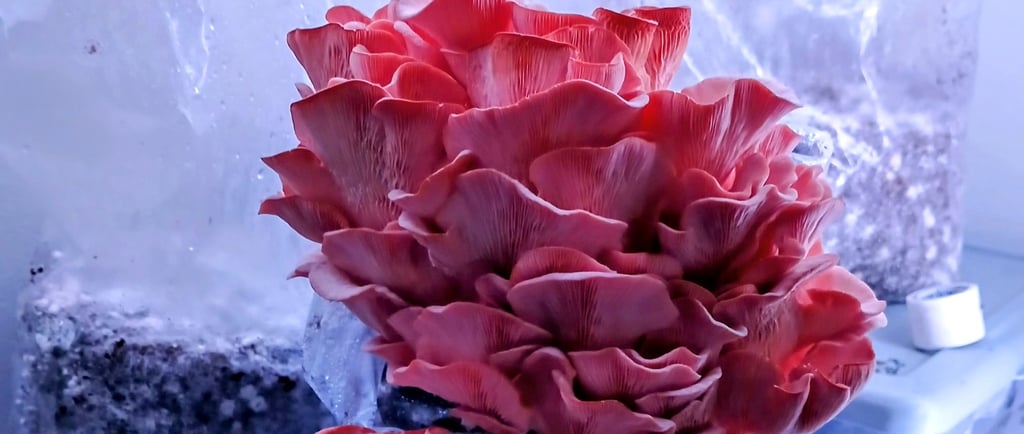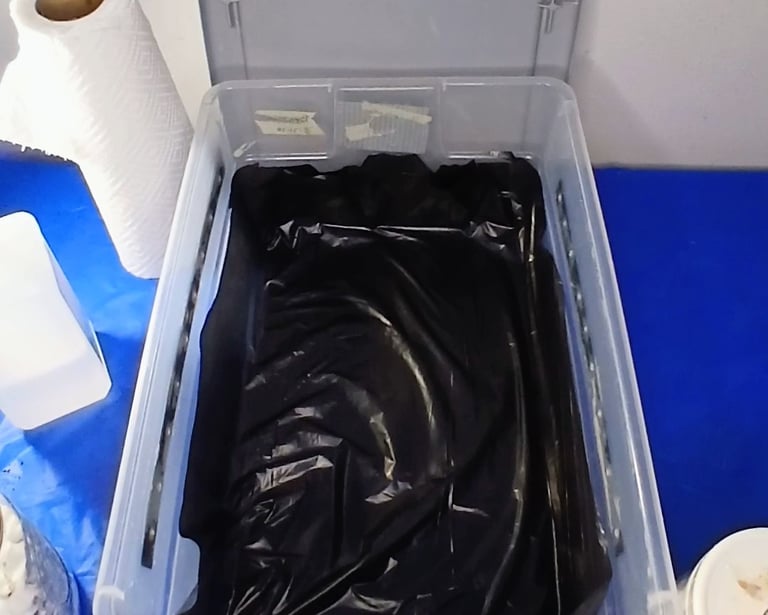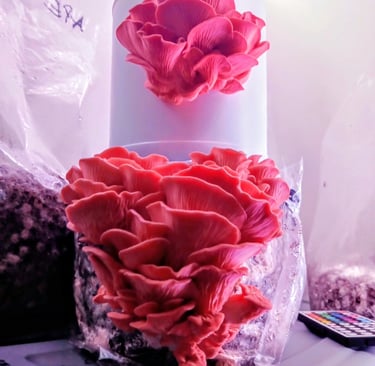Do Mushrooms Grow Back After Harvest? Understanding Flushes & Regrowth
Learn how mushroom flushes work, how to get multiple harvests, prevent side pins, and even regrow spent blocks outdoors. Real grower tips and time-tested tricks.
GROWING
10/16/20253 min read


Do Mushrooms Grow Back After Harvest? Understanding Flushes & Regrowth
When I first got into mushroom growing, I was coming from microgreens — quick crops, one harvest, done. So when I learned mushrooms could regrow multiple times from the same block, it blew my mind.
The idea of getting several harvests, or “flushes,” out of one setup was what really pulled me deeper into mycology. It’s one of those things that makes mushroom growing feel almost magical.
🧠 What Is a Flush?
A flush is one round of mushroom growth and harvest.
After you harvest your first flush, the mycelium rests for a few days, rebuilds energy, and often pushes out a second (and sometimes third) wave of mushrooms.
Most oyster and similar species will give you 2–3 good flushes, sometimes more if your substrate is rich and you keep the environment dialed in. The second flush is usually smaller, but the quality is still great.
🍄 How Mushrooms Regrow
Here’s the cool part: mushrooms regrow from the same mycelium network that’s already colonized your block or tub.
As long as the substrate still has food and the surface stays moist enough, the mycelium keeps fruiting.
After a harvest, some growers mist a little extra or lightly rehydrate the block to encourage the next flush. Others just leave it alone and let nature take over.
🔄 Dealing With Side Pins & Different Containers
When I was new, I didn’t understand why mushrooms would start growing out the sides of my containers instead of the top. Now I know — the mycelium fruits where it finds the best humidity and fresh air, not where you want it to.
If you’re using protein powder containers or buckets, side pins can be tricky since you can’t wrap the plastic tight like a bag.
One little trick that’s worked for me: pore tape over the holes between flushes.
It keeps humidity in, but still allows gas exchange — and the mushrooms will eventually find their way through again.
For top-fruiting bags (like enoki or pioppino), I’ve used rubber bands or even electrical tape to tighten the opening and reduce side pins.
⚠️ Is tape safe?
Yep — in my experience it’s fine. The mushrooms aren’t growing through the tape; there’s still a layer of plastic between it and the fruiting surface.
If you’re ever unsure, use micropore or breathable tape just to be safe.
🧺 How Liners Help in Tubs
If you’re growing in tubs, you might’ve heard about using a liner (a thin trash bag or plastic sheet inside your tub).
This helps stop side pins by keeping the mycelium pressed right against the liner — and when it shrinks after the first flush, the liner pulls away from the wall so mushrooms can’t grow between the two surfaces.
It’s one of those small details that makes a big difference when you’re trying to get clean, easy harvests across multiple flushes.
🕓 When to Call It Done
After two or three flushes, you’ll notice mushrooms stop forming or come in thin and stringy.
That’s when the block is spent — it’s used up its nutrients.
At that point, I usually break it up and compost it, or even bury it outside and sometimes get one last “bonus” flush after a rain.
💭 Final Thoughts
Flushes are what make mushroom growing so rewarding.
It’s amazing watching one block or tub keep giving back after the first harvest.
Whether you’re sealing holes with tape, rehydrating blocks, or just seeing what nature does, remember: each flush is proof your mycelium’s still alive and thriving.
🌱 Bonus: Burying Old Blocks for Surprise Flushes
When I’m done with a block, I don’t always toss it straight in the trash.
I’ve buried old blocks in the garden or yard before — especially after a rain — and sometimes they’ll surprise you with another small flush weeks later.
It doesn’t always work, but when it does, it feels like free food from nature.
The mycelium is tougher than most people think; even after it looks spent, it can bounce back in the right conditions.
If you like the idea of re-using old blocks, check out my guide on [How to Start a Backyard Mushroom Patch]. It’s a simple way to turn spent grows into outdoor harvests.




Cultivation
Helping you master gourmet mushroom cultivation — on or off the grid.
© 2024. All rights reserved.
